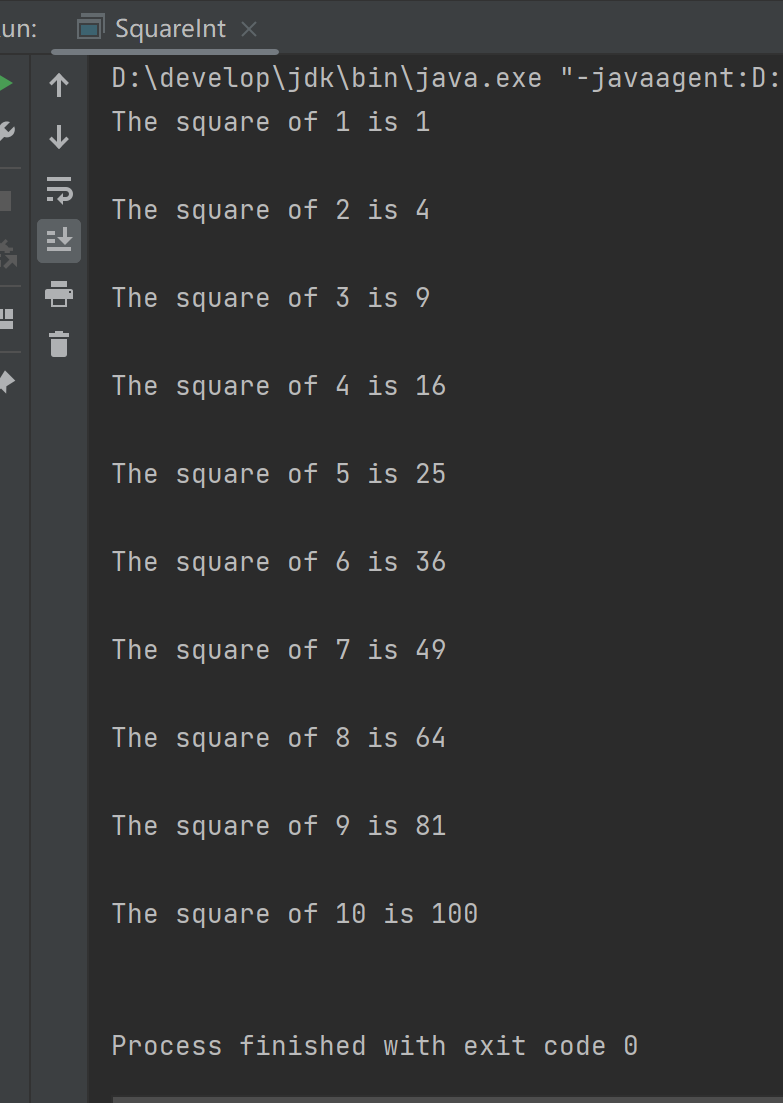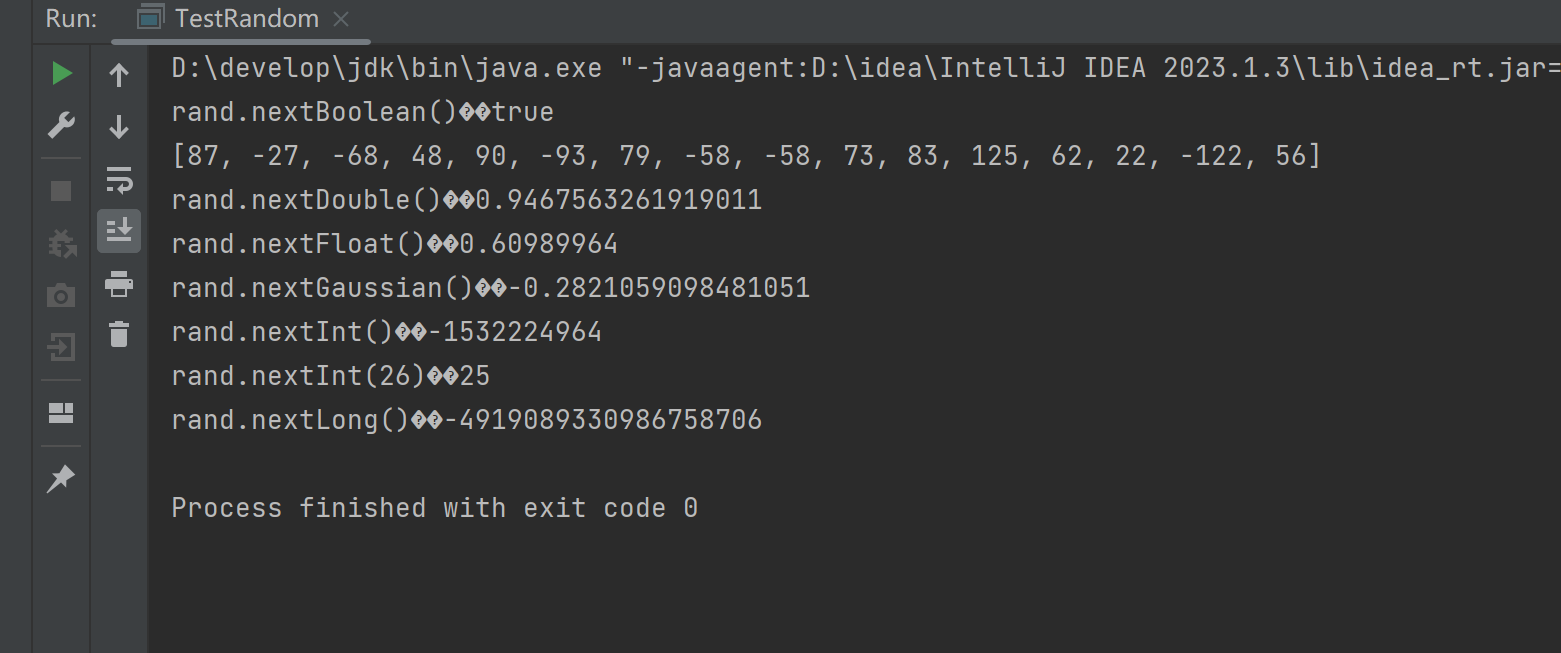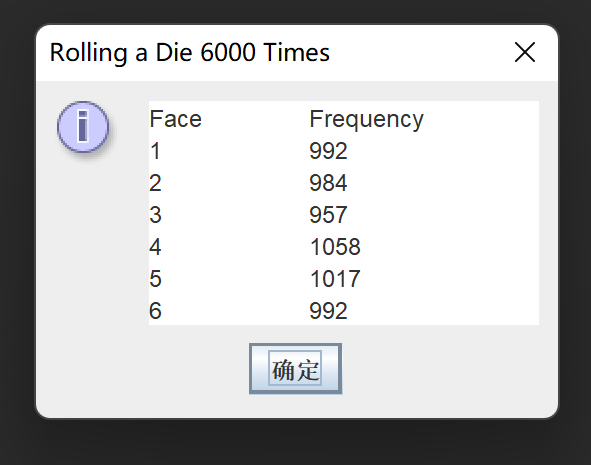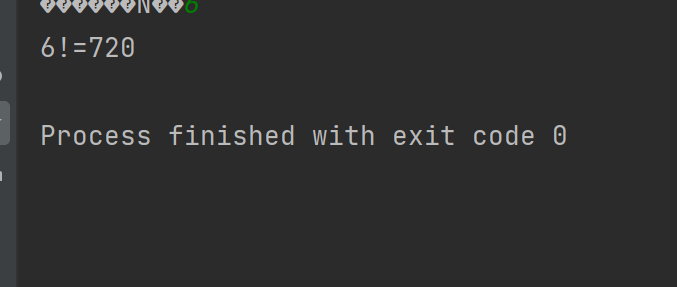软工第二周作业
一、求平均数
(1)源码
1 public class SquareInt { 2 3 public static void main(String[] args) { 4 int result; 5 6 for (int x = 1; x <= 10; x++) { 7 result = square(x); 8 9 // result=(int)Math.pow(x,2); 10 System.out.println("The square of " + x + " is " + result + "\n"); 11 } 12 } 13 14 15 public static int square(int y) { 16 return y * y; 17 } 18 }
(2)运行结果

二、生成随机数
(1)源码
1 // RandomInt.java 2 // Shifted, scaled random integers 3 import javax.swing.JOptionPane; 4 5 public class RandomInt { 6 public static void main( String args[] ) 7 { 8 int value; 9 String output = ""; 10 11 for ( int i = 1; i <= 20; i++ ) { 12 value = 1 + (int) ( Math.random() * 6 ); 13 output += value + " "; 14 15 if ( i % 5 == 0 ) 16 output += "\n"; 17 } 18 19 JOptionPane.showMessageDialog( null, output, 20 "20 Random Numbers from 1 to 6", 21 JOptionPane.INFORMATION_MESSAGE ); 22 23 System.exit( 0 ); 24 } 25 }
(2)运行结果

三、使用Random类生成随机数
(1)源码
1 import java.util.*; 2 3 public class TestRandom 4 { 5 public static void main(String[] args) 6 { 7 Random rand = new Random(); 8 System.out.println("rand.nextBoolean()" + rand.nextBoolean()); 9 byte[] buffer = new byte[16]; 10 rand.nextBytes(buffer); 11 System.out.println(Arrays.toString(buffer)); 12 13 System.out.println("rand.nextDouble()" + rand.nextDouble()); 14 15 System.out.println("rand.nextFloat()" + rand.nextFloat()); 16 / 17 System.out.println("rand.nextGaussian()" + rand.nextGaussian()); 18 // 19 System.out.println("rand.nextInt()" + rand.nextInt()); 20 21 System.out.println("rand.nextInt(26)" + rand.nextInt(26)); 22 // 23 System.out.println("rand.nextLong()" + rand.nextLong()); 24 } 25 }
(2)运行结果

四、随机数应用案例
(1)
1 // RollDie.java 2 // Roll a six-sided die 6000 times 3 import javax.swing.*; 4 5 public class RollDie { 6 public static void main( String args[] ) 7 { 8 int frequency1 = 0, frequency2 = 0, 9 frequency3 = 0, frequency4 = 0, 10 frequency5 = 0, frequency6 = 0, face; 11 12 // summarize results 13 for ( int roll = 1; roll <= 6000; roll++ ) { 14 face = 1 + (int) ( Math.random() * 6 ); 15 16 switch ( face ) { 17 case 1: 18 ++frequency1; 19 break; 20 case 2: 21 ++frequency2; 22 break; 23 case 3: 24 ++frequency3; 25 break; 26 case 4: 27 ++frequency4; 28 break; 29 case 5: 30 ++frequency5; 31 break; 32 case 6: 33 ++frequency6; 34 break; 35 } 36 } 37 38 JTextArea outputArea = new JTextArea( 7, 10 ); 39 40 outputArea.setText( 41 "Face\tFrequency" + 42 "\n1\t" + frequency1 + 43 "\n2\t" + frequency2 + 44 "\n3\t" + frequency3 + 45 "\n4\t" + frequency4 + 46 "\n5\t" + frequency5 + 47 "\n6\t" + frequency6 ); 48 49 JOptionPane.showMessageDialog( null, outputArea, 50 "Rolling a Die 6000 Times", 51 JOptionPane.INFORMATION_MESSAGE ); 52 System.exit( 0 ); 53 } 54 }
(2)运行结果

五、参数可变的方法
(1)源码
1 import java.awt.*; 2 import java.awt.event.*; 3 import java.util.*; 4 5 6 public class VariableArgumentsTest{ 7 8 public static double max(double...values) 9 { 10 double largest=Double.MIN_VALUE; 11 for (double v:values) 12 if(v>largest) largest=v; 13 return largest; 14 } 15 16 public static void main(String args[]) { 17 18 System.out.println("Max:"+max(1,11,300,2,3)); 19 20 } 21 }
(2)运行结果

六、函数重载
(1)源码
1 // MethodOverload.java 2 // Using overloaded methods 3 4 public class MethodOverload { 5 6 public static void main(String[] args) { 7 System.out.println("The square of integer 7 is " + square(7)); 8 System.out.println("\nThe square of double 7.5 is " + square(7.5)); 9 } 10 11 public static int square(int x) { 12 return x * x; 13 } 14 15 public static double square(double y) { 16 return y * y; 17 } 18 }
(2)运行结果

(3)总结
①有重载的方法会根据传入数据的类型来选择不同的方法
②方法重载条件
1.方法名相同
2.参数类型不同,参数个数不同,或者是参数类型的顺序不同
七、递归求n的阶乘
(1)源码
1 import java.math.BigInteger; 2 import java.util.Scanner; 3 4 5 public class CalculateN { 6 7 /** 8 * @param args 9 */ 10 public static void main(String[] args) { 11 12 Scanner scanner=new Scanner(System.in); 13 int number=scanner.nextInt(); 14 System.out.println(number+"!="+calculateN2(number)); 15 16 } 17 18 public static long calculateN(int n) { 19 if(n==1 || n==0){ 20 return 1; 21 } 22 23 return n*calculateN(n-1); 24 } 25 26 public static BigInteger calculateN2(int n) { 27 if(n==1 || n==0){ 28 return BigInteger.valueOf(1); 29 } 30 return BigInteger.valueOf(n).multiply(calculateN2((n-1))); 31 } 32 }
(2)运行结果


